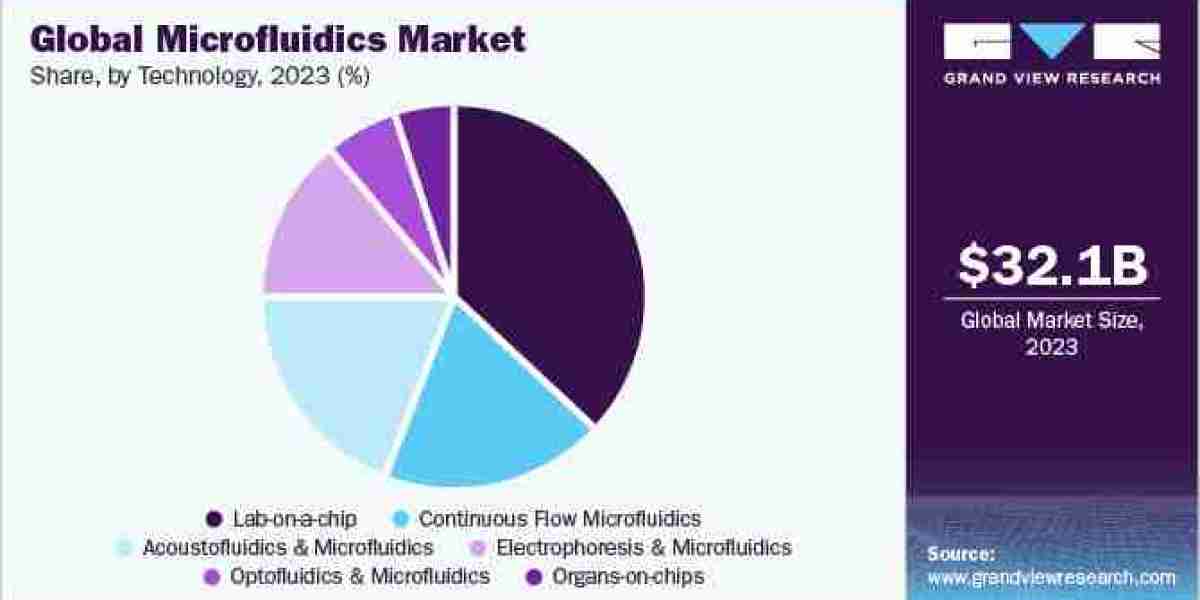Microfluidics Industry Overview
The global microfluidics market size was estimated at USD 32.15 billion in 2023 and is expected to grow at a compound annual growth rate (CAGR) of 12.22% from 2024 to 2030.
The increasing penetration of microfluidics devices in various fields of research and diagnosis is expected to drive market growth. For instance, there has been an improvement in the number of microfluidic devices applicable to ophthalmological conditions over the past decade. Microfluidic approaches have been effectively used to determine glucose levels, detect infection, diagnose dry eye disease, and assess levels of vascular endothelium growth factor. Such applications are expected to positively affect the market growth in the coming years.
Gather more insights about the market drivers, restrains and growth of the Microfluidics Market
An exponential rise in COVID-19 cases globally boosted the demand for microfluidics tools. Many approved tests are based on PCR, making it a preferred technique for COVID-19 diagnosis. To combat the rising cases of COVID-19 globally, several manufacturers have introduced products and ramped up their production to address the growing demand for IVD tests. When coupled with microfluidics, the PCR technique can be accelerated, which, in turn, provides faster test results (from approximately 1 hour to less than 10 minutes) with high accuracy.
For instance, BeforCure, a spin-off company from Elvesys, developed an ultra-fast PCR-on-chip system for the detection of the virus. This product is based on Fastgen technology and leverages the advantages of microfluidics to deliver test results in less than 30 minutes. Furthermore, various studies are being conducted to evaluate the use of microfluidics in COVID-19 detection by PCR technique. A study was published in June 2021 by researchers in China that demonstrated the use of the latest rapid microfluidic PCR. It concluded that rapid PCR can be achieved with the use of emerging state-of-the-art microfluidics for SARS-CoV-2 detection.
The major advantage of microfluidics devices is their ability to analyze small volumes of samples. This reduces the amount of reagent waste and helps preserve samples that are difficult to produce. The introduction of microfluidics devices has driven the demand for low-volume sample devices. A surge in research activities undertaken by analytical and clinical researchers has also driven the demand for microfluidics devices. The conventional method of genome analysis requires decoding the entire DNA, thus adding to the cost of analysis and time. Microfluidics devices need a very small volume of samples for data interpretation. The application of microfluidics has allowed conventional laboratory procedures to be miniaturized onto a lab-on-a-chip.
Browse through Grand View Research's Biotechnology Industry Research Reports.
- The global exosomes market sizewas valued at USD 140.7 million in 2023 and is anticipated to grow at a CAGR of 28.38% from 2024 to 2030.
- The global cord blood banking services market sizewas valued at USD 25.47 billion in 2023 and is projected to grow at a CAGR of 7.4% from 2024 to 2030.
Microfluidics Market Segmentation
Grand View Research has segmented the global microfluidics market based on, technology, material, application, and region:
Microfluidics Application Outlook (Revenue, USD Million, 2018 - 2030)
- Medical/Healthcare
- PCR & RT-PCR
- Gel Electrophoresis
- Microarrays
- ELISA
- Others
- Non-medical
Microfluidics Material Outlook (Revenue, USD Million, 2018 - 2030)
- Silicon
- Glass
- Polymer
- PDMS
- Others
Microfluidics Technology Outlook (Revenue, USD Million, 2018 - 2030)
- Lab-on-a-chip
- Medical
- Non-Medical
- Organs-on-chips
- Medical
- Non-Medical
- Continuous Flow Microfluidics
- Medical
- Non-Medical
- Optofluidics And Microfluidics
- Medical
- Non-Medical
- Acoustofluidics And Microfluidics
- Medical
- Non-Medical
- Electrophoresis And Microfluidics
- Medical
- Non-Medical
Microfluidics Regional Outlook (Revenue, USD Million, 2018 - 2030)
- North America
- S.
- Canada
- Europe
- Germany
- France
- UK
- Italy
- Spain
- Denmark
- Sweden
- Norway
- Asia Pacific
- Japan
- China
- India
- Australia
- Thailand
- Latin America
- Brazil
- Mexico
- Argentina
- Middle East and Africa
- South Africa
- Saudi Arabia
- UAE
- Kuwait
Key Companies profiled:
- Illumina, Inc.
- Hoffmann-La Roche Ltd
- PerkinElmer, Inc.
- Agilent Technologies, Inc.
- Bio-Rad Laboratories, Inc.
- Danaher Corporation
- Abbott
- Thermo Fisher Scientific
- Standard BioTools
Order a free sample PDF of the Microfluidics Market Intelligence Study, published by Grand View Research.


